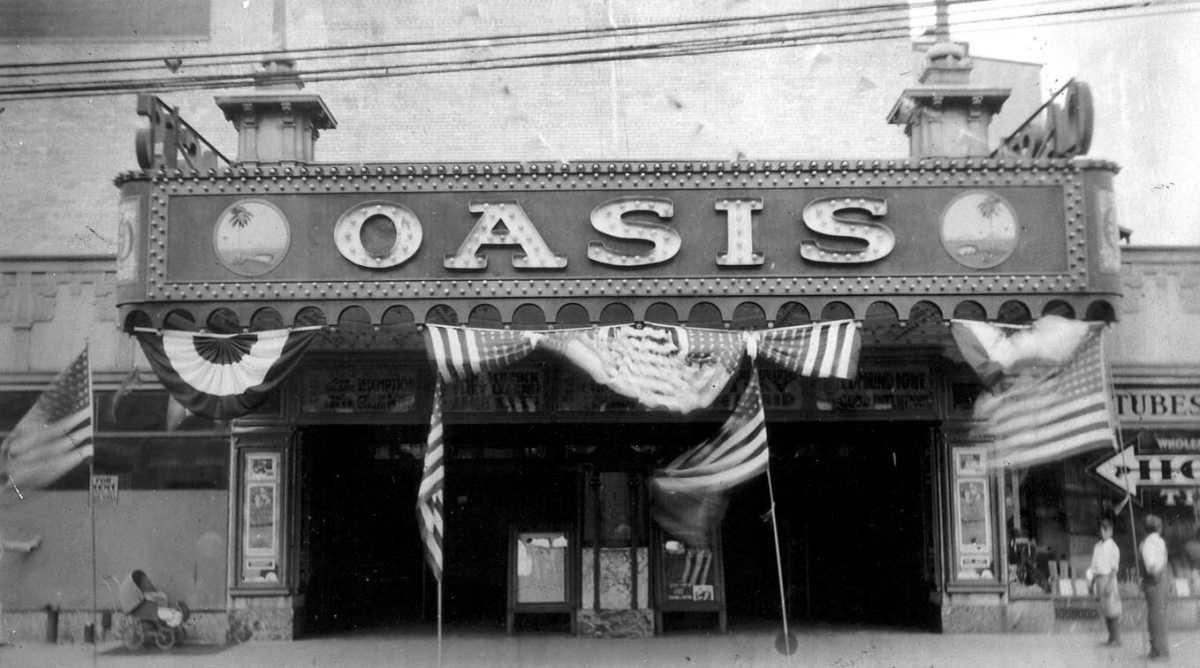You may have read recently about the impending renovations to 63-57 Fresh Pond Rd. in Ridgewood, which at one time was one of our neighborhood’s finest movie houses.
More recently the site of a discount store (and, immediately before that, a CVS Pharmacy), the location was the Oasis Theatre, which opened in 1927 as a 1,700-seat film lover’s paradise. It would last for nearly 50 years before undergoing the first of its many transformations, as a beloved roller rink enjoyed by generations of children.
Sol Brill opened the Oasis Theatre on Sept. 16, 1927, according to Cinema Treasures. It would later become part of what was called the Randforce Circuit, and later became part of the United Artists family.
The Oasis was built in what the New York City Chapter of the American Guild of Organists described as “a subdued Egyptian style, draping the stage opening and surrounding area to suggest a tent that might be found in a desert oasis.”
Though constructed at a time when vaudeville was still a popular form of entertainment in America, the Oasis’ stage was too shallow for such acts. The theater was used strictly for showcasing films, and was constructed during the silent movie era in which there was no recorded dialogue — and most films were accompanied with a soundtrack played in the theater by a pianist or an organist.
Like most movie theaters of its time, the Oasis was equipped with an orchestra pit for up to 15 musicians as well as an organ. The New York City Chapter of the AGO indicated that the Oasis used a Wurlitzer organ built in North Tonawanda, New York which had two manuals, 10 ranks, five tuned percussions, 14 traps and a curved console.
As it happened, 1927 was a revolutionary year in cinema as it marked the debut of “The Jazz Singer,” the first-ever feature film to have recorded dialogue, or “talkie.” The silent movie era soon faded into memory, so did The Oasis’ organ and orchestra pit; by 1929, the theater was equipped with an audio system that replaced live music.
Most of the seats were located on the ground floor; the rest were located in a small balcony.
For the next five decades, The Oasis featured some of the greatest films in cinema. During its first few years, a visitor could expect to see a feature movie along with several short films and newsreels.
According to the New York City Chapter of the AGO, the program changed every three days, and eventually the Oasis showed “double-features,” two movies in one screening.
The growth of television in the 1950s led to dwindling attendance at movie houses across America, and our neighborhood was no exception. The Oasis was one of many Ridgewood movie houses which suffered from changes in the entertainment landscape.
It’s said that the Oasis screened its last film in 1976; ironically, it was “Rocky,” the Oscar-winning tale starring Sylvester Stallone as underdog fighter Rocky Balboa fighting world heavyweight champion Apollo Creed, played by Carl Weathers. Rocky went the distance with Apollo on screen, but the Oasis couldn’t pull itself up off the mat after years of diminished attendance and revenue.

Over the next few years, however, the Oasis found new life after being renovated into “Oasis Roller World,” a roller rink where local youth spun their way around a wooden track for many a date night, birthday party or just an afternoon or evening out.
This Old Timer can remember, as a younger lad, attending a birthday party at the Oasis — and having great difficulty standing upright, let alone navigating the track, on eight small wheels attached to his feet. Being a spectator as others took laps around the wooden oval wasn’t such a bad thing.
In researching this piece, we found some interesting video on YouTube of an actual roller skating enthusiast enjoying the Oasis rink and some great music of the 1980s.
But the Oasis Roller World would eventually go out of business and be transformed into a CVS Pharmacy during the 1990s. By 2013, the CVS relocated down the block to the former site of Meyer Chevrolet, at the corner of Metropolitan Avenue and Fresh Pond Road.
Closeout Paradise, a discount store, would occupy the former Oasis site the next year, but went out of business within a few years.

What are your memories of the Oasis Theatre and Oasis Roller World? We’d love to hear them. Drop us a line! Email us at editorial@qns.com.
Sources: Cinematreasures.org, the New York City Chapter of the American Guild of Organists, YouTube and the Ridgewood Times.
* * *
If you have any remembrances or old photographs of “Our Neighborhood: The Way It Was” that you would like to share with our readers, please write to the Old Timer, c/o Ridgewood Times, 38-15 Bell Blvd., Bayside, NY 11361, or send an email to editorial@qns.com. Any print photographs mailed to us will be carefully returned to you upon request.



































